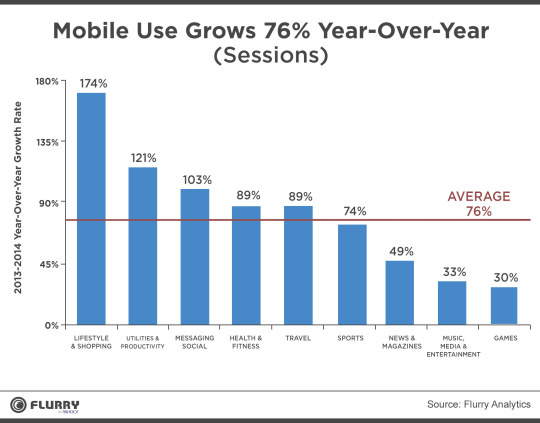January 6, 2015 | Simon Khalaf
In the six years that Flurry has been reporting on our mobile app usage, and in some cases addiction, we’ve seen stunning growth. This last year was no different. According to Flurry Analytics, in 2014 overall app usage grew by 76%. In this context, Flurry defines app usage as a user opening an app and recording what we call a session. In 2014, Shopping, Utilities & Productivity, and Messaging experienced triple-digit growth and were the key drivers. As our mobile devices become more and more a part of our everyday lives, we are increasingly using them for always-on shopping, working, and communication. Where years past have seen massive growth in games and entertainment, 2014 was the year apps got down to serious business.
Mobile Use Grows 76% in 2014

Every app store category has again seen session growth in 2014. While 2013 was the year messaging apps took off, 2014 was the year retail came to mobile in a big way.
Sessions in shopping apps on iOS and Android increased by a whopping 174% year-over-year (note: for iOS, the “Lifestyle” category includes more than shopping). On Android alone, the shopping category increased by 220%.
Smartphone users opened more Utilities & Productivity apps in 2014, confirming that our phones and tablets have become indispensable devices that help us work and keep our lives organized. We need look no further than Microsoft’s mobile moves this past year. The quintessential productivity suite - Office - is now available on mobile, and not just Windows devices but Apple and Android. Microsoft also made other moves to show its commitment to mobile by buying email app Acompli. It makes sense that productivity in the cloud should be mobile-first, powering the “anytime, anywhere” nature of the way we work today.
Messaging, which propelled mobile to grow 115% in 2013, also posted triple digit growth this year, as messaging apps have become platforms themselves exposing other services such as payments in the case of SnapChat and Japan’s LINE, and games distribution in the case of TenCent’s WeChat. We agree with Fred Wilson that these Asian messaging powerhouses will set their sights on the US market this year.
Some of the early mainstays of mobile appear to be maturing. Growth in Games sessions continues, but that growth has slowed from 61% in 2013 to 30% in 2014. The same is true for Music, Media, and Entertainment: the growth rate has slowed to 33% from 79% last year. This double-digit growth is impressive in any context, but we are witnessing a shift where the growth in mobile has moved from apps for entertainment to apps that help us accomplish our daily tasks.
A Store in Your Pocket, Wherever You Are

To better understand Shopping apps’ phenomenal year, we took a deeper look at where and when we are using them. Based on a sample of Android devices in the US, we were able to plot engagement with Shopping apps by zip code. We estimated the zip code of “Home” versus “Away” by looking at the zip code where the most activity happened in the 11 p.m. to 5 a.m. time frames. Activity outside of this zip code we labeled “Away.”
Based on this analysis, our mobile shopping behavior is perhaps what we might expect. We shop on our phones when we are out and about during the day, with Shopping app use spiking during the commute time of 9 a.m. and lunchtime at noon. We’re focused on things other than shopping in the afternoon hours (perhaps working to support that shopping habit), but mobile shopping spikes again during prime time at 8 p.m., at home. There are some of us that shop all night into the wee hours of the morning!
These new behavior patterns present great opportunities and challenges for retailers. Target stores have said it views “mobile as the new front door to Target”, and that mobile front door is increasingly in-app. In 2014 68% of time spent on Target mobile properties was in-app vs. web, up from 21% in 2013, according to Comscore. Retailers need to adjust to the new reality of a multitude of stores in every consumer’s pocket, 24 hours a day, 7 days a week.
Tracking Four Million Sessions Every Minute
In 2014, Flurry Analytics tracked 2.079 trillion sessions - a mind-boggling number. On December 31st we set another daily session record with 8.5 billion sessions as people celebrated the approaching New Year chatting, sharing, looking for rides, and navigating New Year’s Eve. We’ve witnessed another explosive year of growth in mobile and have entered a new phase of the mobile revolution where we get down to business. We can’t wait to see what 2015 brings.